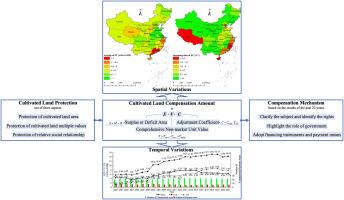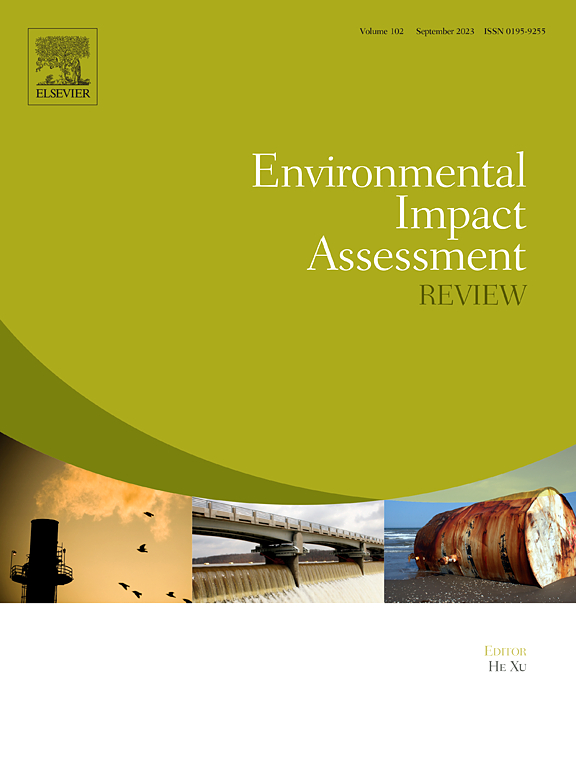中国大陆耕地补偿的时空变化及其补偿机制
IF 9.8
1区 社会学
Q1 ENVIRONMENTAL STUDIES
引用次数: 0
摘要
耕地补偿可以缓解耕地保护与社会经济发展之间的矛盾。探索耕地补偿的时空变化趋势,制定科学合理的补偿机制,对实现耕地的可持续发展具有重要意义。为分析中国大陆耕地面积、非市场综合价值和补偿金额的时空变化,本文构建了包括正生态价值、负生态价值和社会价值在内的非市场综合价值评价框架,并设计了可行的耕地补偿模型。从耕地面积看,耕地面积总体呈盈余状态,2000-2021 年每年净盈余面积为 5440 万公顷。在空间尺度上,净盈余区主要集中在华北和华中地区,净亏损区主要集中在东南沿海发达地区。在非市场综合价值方面,除生态价值为负值外,其他非市场价值均有所增加。在空间尺度上,非市场综合价值与区域经济发展的耦合关系明显,东南沿海发达省份的非市场综合价值较高,内陆发展中省份的非市场综合价值较低。从补偿金额来看,补偿地区的补偿总额难以覆盖被补偿地区的补偿总额,两者之间出现了一定的补偿差距,2000-2021 年平均为 6.03 万亿元。在空间尺度上,赔付区主要分布在东南沿海地区,赔付区数量少于补偿区数量。建议明确耕地补偿主体,明确耕地补偿权责;突出中央政府主导作用,充分发挥各级政府主体作用;因地制宜,采取多元化市场融资手段;制定相关配套保障制度。本文章由计算机程序翻译,如有差异,请以英文原文为准。

Spatial-temporal variations of cultivated land compensation and its compensation mechanism in mainland China
Cultivated land compensation can alleviate the conflict between cultivated land protection and socio-economic development. Exploring the spatial-temporal trends of cultivated land compensation, and formulating a scientific and reasonable compensation mechanism are important to achieve sustainable development. To analyze the spatial-temporal changes of the area, comprehensive non-market value, and compensation amount of cultivated land in mainland China, this paper constructed a comprehensive non-market value evaluation framework including positive ecological, negative ecological, and social values, and designed a feasible cultivated land compensation model. In terms of cultivated land area, the cultivated land area indicated an overall surplus condition, and the total net surplus area during 2000–2021 was 54.4 million hectares per year. On a spatial scale, the net surplus districts were concentrated in the north and the center of China, while the net deficit districts were in the developed areas along the southeast coast. In terms of comprehensive non-market value, except for negative ecological value, all other non-market values had increased. On a spatial scale, the coupling relationship between comprehensive non-market value and regional economic development was obvious, presenting a higher value observed in the southeastern coastal developed provinces, and a lower one in the developing inland provinces. In terms of compensation amount, the total payment amount of the payment districts was difficult to cover the total compensation amount of the compensated districts, a certain compensation gap between the two appeared, averaging 6.03 trillion RMB during 2000–2021. On a spatial scale, the payment districts were mainly distributed in the southeastern coastal area, and the number of the payment districts was smaller than that of the compensated area. It is suggested that we should clarify the subject of cultivated land compensation and identify its rights and responsibilities, highlight the leading role of the central government and give full play to the main role of all levels of government, adopt diversified market financing instruments according to local conditions, and formulate relevant supporting security systems.
求助全文
通过发布文献求助,成功后即可免费获取论文全文。
去求助
来源期刊

Environmental Impact Assessment Review
ENVIRONMENTAL STUDIES-
CiteScore
12.60
自引率
10.10%
发文量
200
审稿时长
33 days
期刊介绍:
Environmental Impact Assessment Review is an interdisciplinary journal that serves a global audience of practitioners, policymakers, and academics involved in assessing the environmental impact of policies, projects, processes, and products. The journal focuses on innovative theory and practice in environmental impact assessment (EIA). Papers are expected to present innovative ideas, be topical, and coherent. The journal emphasizes concepts, methods, techniques, approaches, and systems related to EIA theory and practice.
 求助内容:
求助内容: 应助结果提醒方式:
应助结果提醒方式:


